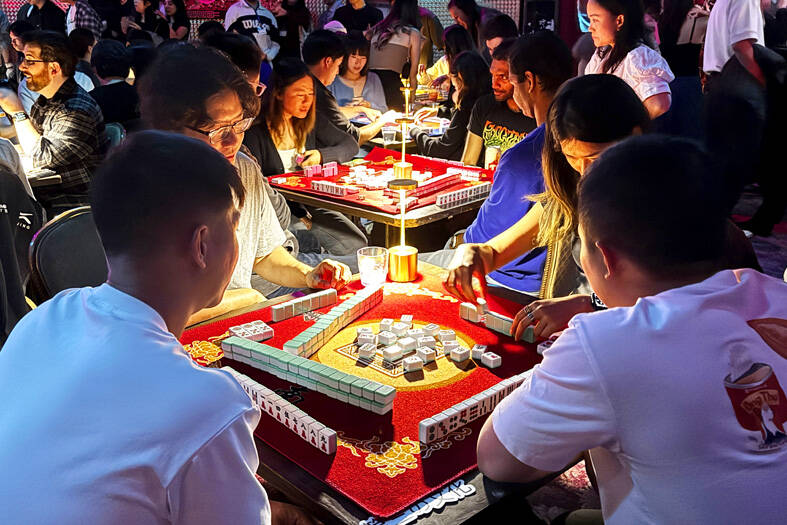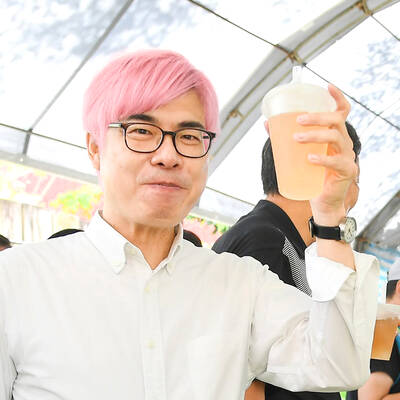When Ryan Lee first played mahjong two years ago, he got hooked. He dug out sets of the classic Chinese tile game from his parents’ house and brought them to San Francisco, where he started hosting mahjong nights in his apartment.
The gatherings became so popular that the 25-year-old Chinese American began hosting pop-up mahjong parties in restaurants, bars and nightclubs around San Francisco.
Mahjong, invented in 19th century China, is gaining popularity with a new generation of players looking to get off their phones and socialize in the real world.

Photo: AP
Lee’s Youth Luck Leisure (YLL) Mahjong Club now hosts bimonthly parties with up to 30 tables and 200 guests. They attract a diverse, young crowd drawn to the festive atmosphere, live DJs, custom cocktails and chance to meet new friends. Instructors are on hand to teach novices.
“A lot of people are just really intrigued even though they don’t really know how to play,” Lee said. “There’s a cultural component they’re trying to connect with. It’s kind of like a cultural nostalgia.”
Eventbrite reports there was a 179 percent increase in US mahjong events on its platform from 2023 to 2024.
There’s been a 179 percent increase in mahjong events in the US from 2023 to last year, according to Eventbrite, a popular ticketing app. The event platform says Gen Z is also showing a growing interest in other “grannycore” activities such as baking workshops and needlework circles that happen offline.
In mahjong, four players draw and discard tiles with different suits, numbers and Chinese characters. The object is to build a winning hand of four sets of three and one pair.
“It’s a really tactile game, and it’s really a social game. It really easily builds community among people,” said Nicole Wong, a writer and audio producer in Oakland. “It’s a good way to unplug and not just be on your phone.”
Wong learned how to play when she visited her Chinese grandparents in New Zealand in 2009. Several years ago she found her parents’ mahjong table and game sets, and started hosting mahjong nights with her friends.
In 2019, she launched The Mahjong Project, an instructional guide and oral history project inspired by her family’s love of the game. That led her to publish Mahjong: House Rules from Across the Asian Diaspora, an illustrated book that explores the game’s history, strategies, traditions and styles of play.
“For the Asian American community, I think there’s interest in connecting to your heritage and your culture in a way that was not the case when I was growing up,” Wong said.
YLL Mahjong Club has held nearly 20 events in San Francisco since it started last year. Lee said it’s an opportunity to introduce people to the game as well as bring business to local restaurants, bars and food vendors. Lee’s sister started hosting similar events in Los Angeles. There are plans to expand to other US cities.
“The demand is rising,” said Lee, a management consultant in business school. “It’s not just an interest to learn how to play mahjong, but to find a third space or another community to do things with.”
Joyce Yam, YLL Mahjong Club’s sponsorship manager, helps manage the San Francisco events, which sell out fast and have long waiting lists.
“We welcome people who have no experience at mahjong at all, and we have TA’s who teach the people how to play the game. And they love it so much that they keep coming back,” Yam said.
Ethan Vuong, a Florida native who lives in San Francisco, started playing with friends a couple years ago. He saw it as a way to connect with his Chinese heritage and make new friends. He’s a regular at Oakland’s Baba House and YLL Mahjong Club events, where he volunteers to teach newcomers.
“It’s not just a skill or mechanics-based game, it’s an expression of your personality,” Vuong said. “I just keep playing because I have this goal that I’m going to beat my grandma one day.”

Taiwan is one of the world’s greatest per-capita consumers of seafood. Whereas the average human is thought to eat around 20kg of seafood per year, each Taiwanese gets through 27kg to 35kg of ocean delicacies annually, depending on which source you find most credible. Given the ubiquity of dishes like oyster omelet (蚵仔煎) and milkfish soup (虱目魚湯), the higher estimate may well be correct. By global standards, let alone local consumption patterns, I’m not much of a seafood fan. It’s not just a matter of taste, although that’s part of it. What I’ve read about the environmental impact of the

It is jarring how differently Taiwan’s politics is portrayed in the international press compared to the local Chinese-language press. Viewed from abroad, Taiwan is seen as a geopolitical hotspot, or “The Most Dangerous Place on Earth,” as the Economist once blazoned across their cover. Meanwhile, tasked with facing down those existential threats, Taiwan’s leaders are dying their hair pink. These include former president Tsai Ing-wen (蔡英文), Vice President Hsiao Bi-khim (蕭美琴) and Kaohsiung Mayor Chen Chi-mai (陳其邁), among others. They are demonstrating what big fans they are of South Korean K-pop sensations Blackpink ahead of their concerts this weekend in Kaohsiung.

The captain of the giant Royal Navy battleship called his officers together to give them a first morsel of one of World War II’s most closely guarded secrets: Prepare yourselves, he said, for “an extremely important task.” “Speculations abound,” one of the officers wrote in his diary that day — June 2, 1944. “Some say a second front, some say we are to escort the Soviets, or doing something else around Iceland. No one is allowed ashore.” The secret was D-Day — the June 6, 1944, invasion of Nazi-occupied France with the world’s largest-ever sea, land and air armada. It punctured Adolf

The first Monopoly set I ever owned was the one everyone had — the classic edition with Mr Monopoly on the box. I bought it as a souvenir on holiday in my 30s. Twenty-five years later, I’ve got thousands of boxes stacked away in a warehouse, four Guinness World Records and have made several TV appearances. When Guinness visited my warehouse last year, they spent a whole day counting my collection. By the end, they confirmed I had 4,379 different sets. That was the fourth time I’d broken the record. There are many variants of Monopoly, and countries and businesses are constantly